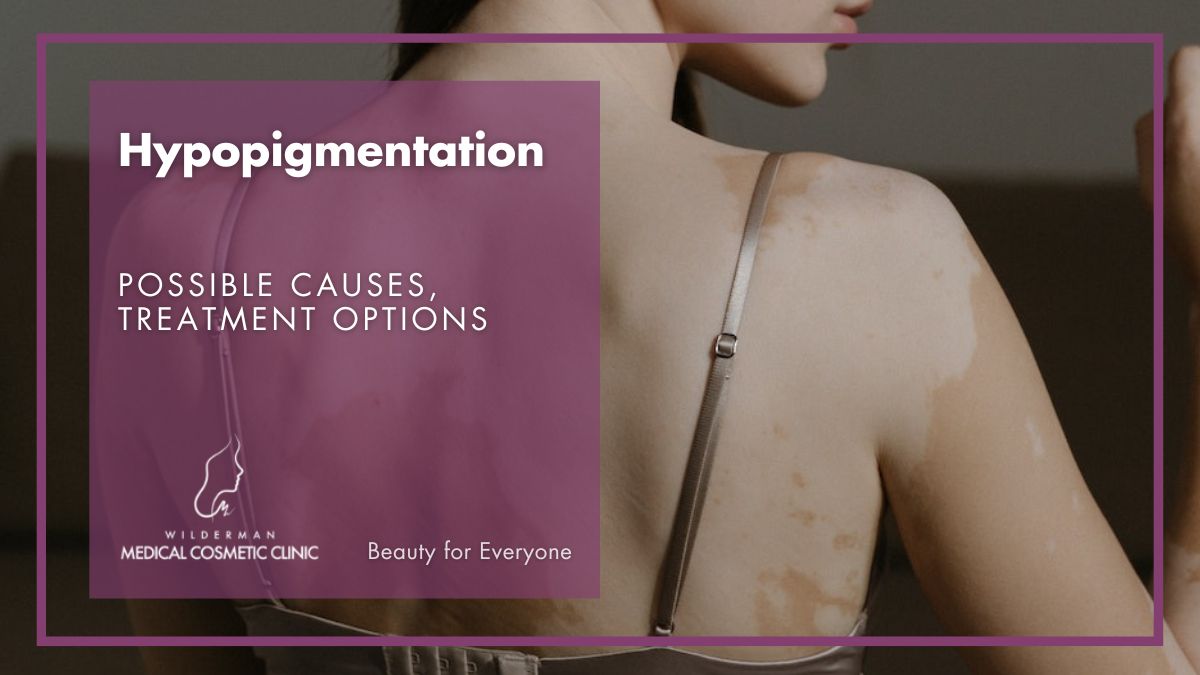Hypopigmentation
Possible Causes, Treatment Options
Hypopigmentation refers to a condition characterized by a loss or reduction in the pigment melanin, which gives color to the skin, hair, and eyes.
This condition can manifest in various forms, affecting individuals of different ages and skin types.

Get immediate answers about possible treatment options tailored for you, expected results, and much more.
- Expert Diagnosis
- Customized Treatment Plans
- No Obligation
- Comfort and Privacy
- Immediate Answers
Hereinafter, we will delve into the definition of hypopigmentation, explore its potential causes, discuss different types, and highlight available treatment options.
What is Hypopigmentation?
Hypopigmentation is a condition in which the skin, hair, or eyes lose their natural color.
It occurs due to a decrease in the production, distribution, or functionality of melanin, the pigment responsible for determining our skin, hair, and eye color. The affected areas may appear lighter, white, or even translucent compared to the surrounding skin.
Possible Causes of Hypopigmentation
- Skin Damage or Trauma: Skin injuries, burns, infections, or inflammatory skin conditions can cause hypopigmentation. These factors can disrupt the normal functioning of melanocytes, leading to reduced pigment production in the affected areas.
- Fungal Infections: Certain fungal infections, such as tinea versicolor, can cause hypopigmented patches on the skin. These infections disrupt the normal functioning of melanocytes, leading to reduced melanin production.
- Nutritional Deficiencies: Deficiencies in certain nutrients, such as vitamin B12, folate, copper, or zinc, can impact melanin production and result in hypopigmentation.
- Chemical Exposure: Exposure to certain chemicals, such as industrial chemicals, toxins, and some medications, can disrupt melanocyte function and lead to hypopigmentation.
- Eczema: Eczema is a condition that causes the skin to become dry, inflamed, itchy, and bumpy. Eczema can lead to changes in skin color, including hypopigmentation.
- Psoriasis: Psoriasis is a chronic disorder characterized by the development of thick, scaly patches, known as plaques, on the skin. These plaques are often red or pink in color and can be itchy and uncomfortable. In some cases, once the plaques resolve or go away, hypopigmentation may appear in the affected areas.
- Albinism: Albinism is a genetic disorder characterized by a complete or partial absence of melanin in the skin, hair, and eyes. People with albinism typically have very light or white hair, pale skin, and light-colored irises. They often experience heightened sensitivity to sunlight and are more prone to sunburn and vision problems.
- Vitiligo: Vitiligo is an autoimmune condition in which the immune system mistakenly attacks and destroys melanocytes, resulting in depigmented patches on the skin. These patches can vary in size and shape and are usually more noticeable on areas exposed to sunlight, such as the face, hands, elbows, knees, and genitals. Vitiligo can occur at any age and affects individuals of all races and ethnicities.
- Halo Nevus: Halo nevus is a type of mole (nevus) characterized by a depigmented or hypopigmented ring surrounding a pigmented mole. The immune system targets and destroys the melanocytes in the area surrounding the mole, resulting in hypopigmentation.
- Xeroderma Pigmentosum: Xeroderma pigmentosum is a rare genetic disorder that affects the skin’s ability to repair DNA damage caused by ultraviolet (UV) radiation. Individuals with this condition are extremely sensitive to sunlight and have an increased risk of developing skin cancer. Hypopigmentation can occur in areas of the skin that have been damaged by UV radiation.
- Piebaldism: Piebaldism is a genetic disorder characterized by patches of depigmented or hypopigmented skin and hair. The affected areas typically have a well-defined border and are often present from birth. Piebaldism is caused by a mutation in the KIT gene, which is involved in melanocyte development.
- Medications and Treatments: Some medications, such as certain chemotherapeutic drugs, may cause temporary or permanent hypopigmentation as a side effect. Additionally, certain laser treatments, chemical peels, or radiation therapy can affect melanocyte function, resulting in depigmented patches.
It is important to note that the specific cause of hypopigmentation can vary from person to person, and a thorough evaluation by a healthcare professional is necessary to determine the underlying cause in each case.
Treatment Options for Hypopigmentation
While complete restoration of pigmentation may not always be possible, several treatment approaches can help manage the condition and improve the appearance of the affected areas. Here are some common treatment options:
- Topical Corticosteroids: Corticosteroid creams or ointments may be prescribed to reduce inflammation and promote repigmentation in certain cases, particularly for post-inflammatory hypopigmentation. These medications can help stimulate melanocyte activity and encourage the production of melanin in the affected areas.
- Topical Calcineurin Inhibitors: Topical calcineurin inhibitors, such as tacrolimus or pimecrolimus, are often used in the treatment of vitiligo. These medications modulate the immune response, helping to suppress the autoimmune destruction of melanocytes and promote repigmentation.
- Topical Retinoids: Retinoid creams or gels containing vitamin A derivatives may be prescribed to promote cell turnover and enhance repigmentation.
- Psoralen plus Ultraviolet A (PUVA) Therapy: This treatment involves the use of a psoralen medication (taken orally or applied topically) followed by exposure to ultraviolet A (UVA) light. It can stimulate melanin production and promote repigmentation in certain cases of hypopigmentation, such as vitiligo.
- Narrowband UVB Phototherapy: Narrowband UVB (Ultraviolet B) phototherapy involves controlled exposure to specific wavelengths of UVB light. This treatment modality stimulates melanocyte activity and encourages repigmentation. It is commonly used for vitiligo treatment and may require multiple sessions over a period of time.
- Excimer Laser: Excimer laser treatment is another option for repigmentation in cases of vitiligo or localized hypopigmentation. The laser emits UVB light of specific wavelengths, targeting the depigmented areas and stimulating melanocyte regeneration.
- Micropigmentation (Tattooing): Micropigmentation, also known as medical tattooing or cosmetic tattooing, involves the implantation of pigment into the skin to match the surrounding areas. It can be used to camouflage hypopigmented patches and create a more even skin tone.
- Dermabrasion: Dermabrasion is a technique that involves the controlled removal of the outermost layers of the skin using a rotating brush or a diamond-tipped instrument. This procedure helps to resurface the skin and promote the growth of new, healthier skin cells. In some cases of hypopigmentation, dermabrasion can stimulate melanocyte activity and encourage repigmentation.
- Chemical Peels: Chemical peels involve the application of a chemical solution to the skin, which exfoliates the outer layers and promotes skin regeneration. Depending on the specific formulation and strength of the chemical peel, it can address various skin concerns, including hypopigmentation. Chemical peels can help stimulate melanin production and improve the overall skin tone and color.
- Laser Resurfacing or Therapy: Laser resurfacing or therapy utilizes high-energy laser beams to target and remove damaged skin layers. The procedure promotes collagen production and stimulates the growth of new skin cells. In some cases, laser treatments can help address hypopigmentation by promoting repigmentation and improving the skin’s overall color and tone.
- Camouflage Makeup: Specialized cosmetics, such as camouflage makeup or concealers, can be used to temporarily conceal hypopigmented areas and create the appearance of more uniform skin tone. These products can provide effective coverage and are particularly useful for social or cosmetic purposes.
It is important to note that the choice of treatment depends on the underlying cause, the extent of hypopigmentation, and individual factors.
An aesthetic physician or healthcare professional should evaluate each case and recommend the most suitable treatment approach tailored to the specific needs of the patient.
Conclusion
Hypopigmentation occurs when the skin cells produce insufficient pigment, resulting in lighter patches of skin compared to the surrounding areas. In some cases, hypopigmentation may improve or resolve spontaneously.
However, if a skin condition is responsible for the hypopigmentation, medications can be prescribed to help restore color to the affected skin. It is important to note that if hypopigmentation is due to a genetic condition, it may be permanent.
To protect your skin, it is crucial to use sunscreen regularly. Sunscreen helps shield the skin from harmful UV rays and prevents further damage to the skin’s pigment.
Hypopigmentation can sometimes lead to self-consciousness and affect mental health. If you find that your hypopigmentation is impacting your well-being, it is advisable to seek support from a healthcare professional. They can offer guidance, reassurance, and recommend appropriate interventions to address any psychological or emotional challenges associated with the condition.
Reference
Cleveland Clinic. (Jun 27, 2022). Hypopigmentation. Retrieved from https://my.clevelandclinic.org/health/symptoms/23363hypopigmentation. (Accessed Jul 4, 2023).
Medical News Today. (Updated on Nov 11, 2020). Hypopigmentation: Causes, types, and treatments. Retrieved from https://www.medicalnewstoday.com/articles/323808 (Accessed Jul 4, 2023).
Healthline. (Updated on Jun 26, 2023). Hypopigmentation: Causes, types, and treatment. Retrieved from https://www.healthline.com/health/skin-disorders/hypopigmentation#treatment (Accessed Jul 4, 2023).
American Society for Dermatologic Surgery. (n.d.). Micropigmentation for Vitiligo. Retrieved from https://www.asds.net/skin-experts/skin-treatments/micropigmentation/migropigmentation-for-vitiligo (Accessed Jul 4, 2023).
Kayakalp Global. (n.d.). Vitiligo – Other Treatment Options. Retrieved from https://www.kayakalpglobal.com/vitiligo-other-treatment-option.php (Accessed Jul 4, 2023).

Other skin conditions that may be of interest
Skin Laxity: A common skin concern – Skin laxity is a common concern that many individuals experience as they age. It is characterized by a loss of firmness, elasticity, and resilience in the skin, leading to a less …
Sagging Skin – As we age, one of the most common concerns we face is sagging skin. The loss of elasticity and firmness can affect various parts of our body, including the face, neck, arms, and abdomen. Sagging skin can be attributed to …
Stretch Marks: Causes, Treatments, Prevention – Stretch marks, also known as striae, are a common skin condition that affects both men and women. They often appear as visible lines on the skin, typically on …
Spider Veins and Broken Capillaries – Spider veins and broken capillaries are common vascular conditions that affect a significant number of people. While they are typically harmless, they can cause cosmetic concerns for …
Melasma – Melasma is a common skin condition characterized by the development of brown or gray patches on the face, most commonly on the cheeks, forehead, upper lip, and chin. While melasma does not pose any …
Smoker’s lines: A real connection to smoking? – Smoker’s lines, also known as lip lines, lipstick lines, or perioral wrinkles, are fine lines that develop around the mouth and lips. These lines can be unsightly and may contribute to …
Acne Scarring: Causes, Treatment, Prevention – Acne is a common skin condition that affects millions of people worldwide, causing physical and emotional distress. In some cases, acne can leave behind unsightly scars, further impacting …
Dark Under-Eye Circles – Dark under-eye circles can be frustrating and make you appear tired or older than you actually are. They are a common cosmetic concern that affects people of all ages. We will explore what …
Stay Ahead of the Beauty Curve
Beyond Beauty: Elevate Your Routine with Insider Tips and Breakthroughs – Subscribe Now!
Transform your beauty routine into something extraordinary!

